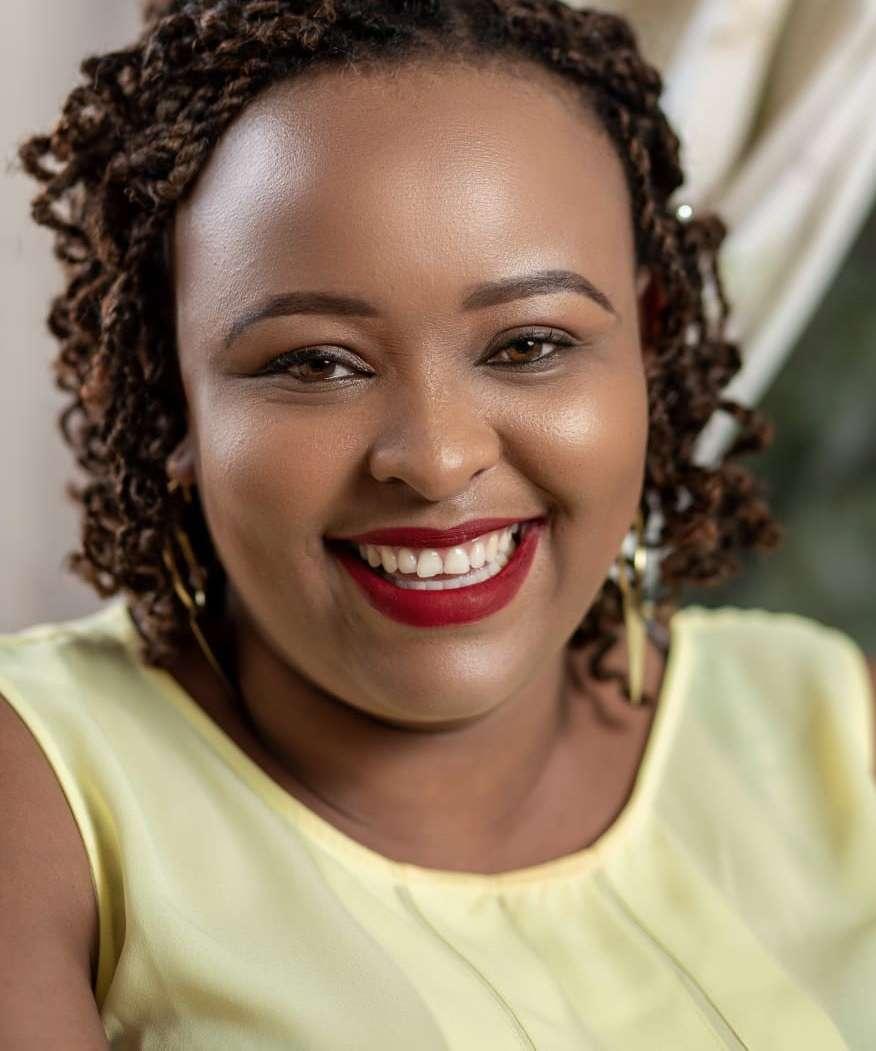
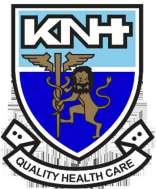



Editor’s note p.2
Trailblazer: The first and only female Interventional Radiologist in Kenya p.3-4 Conjoined Siamese twins celebrate one-year birthday at KNH p.5 - 6 Positive mentions from KNH socials p. 6 Equal opportunity for all: Gender and Disability mainstreaming at KNH p 7- 8 Importance of communication between departments in an organization p.9 Key achievements of the KNH Expansion project date back to the 80’s p.10- 11 KNH School of Nursing holds its 15th Graduation Ceremony p. 12
The intern’s experience p. 12 A day well spent takes more than the act of waking up p.13-14 Our story in Pictures p.15
KPCC Customer Service Workshop: Embedding customer service skills p. 16 Hospital marks World AIDS Day 2022 p. 17 KNH Executive Management Committee joins the Adopt-A-Bed Campaign p. 18 Comic zone p. 19
Trailblazer: The first and only female Interventional Radiologist in Kenya p. 3
Design Concept Team: Dave Opiyo, Edel Q. Mwende, Yvonne Gichuru & Collins Cheruiyot
Editorial Team: Dave Opiyo , Edel Q. Mwende, Phillip Etyang, Yvonne Gichuru, Luke Kung’u, Priscah Angwenyi, Shiphrah Njeri, Mohamed Dima & Winfred Gumbo
Stories: Verah Mugambi, Philip Etyang, Luke Kung’u, Marian Moraa, Shiphrah Njeri, Edel Q. Mwende, Priscah Angwenyi, Yvonne Gichuru & Sally Keino
Design By: Collins Cheruiyot
Photos: Steve Arwa & Luke Kung’u
Tel: +254 20 2726300-9 Ext. 43121 or 43969 Fax: +254 20 272572
Email: caffairs@knh.or.ke knh.caffairs@gmail.com
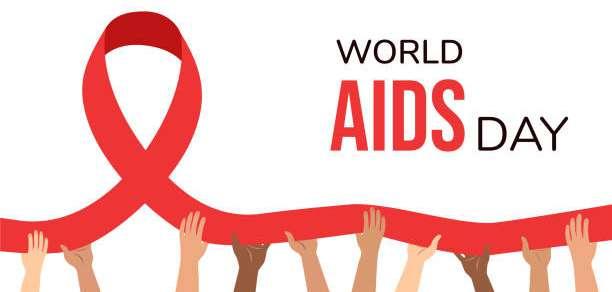
Every year, on 1st December, Kenyatta National Hospital (KNH) joins the world in commemorating World AIDS Day. This International day is dedicated to spreading awareness amongst people and nations about the Acquired Immune Deficiency Syndrome (AIDS) pandemic caused due to the spread of Human Immunodeficiency Virus (HIV) infection and to support those people globally who are living with HIV as well as remember those who lost their lives to AIDS.
The theme of World AIDS day 2022 is ‘Equalize’. It implies that everyone should unite in fighting the inequalities that stop people from getting the life-saving healthcare and support they need. This year’s chosen subject is the most recent in a long line of concerns. According to KNH Aids Control Unit (ACU), the inequalities which perpetuate the AIDS pandemic are not inevitable; we can tackle them. This World AIDS Day, the hospital is urging each of us to address the inequalities which are holding back the progress in ending AIDS.
In 2021, there were approximately 38.4 million people across the world living with HIV. Out of these, 36.7 million were adults and the remaining 1.7 million were children (less than 15 years old). Additionally, 54% were women and girls.
In today’s times, HIV treatment has seen scientific advancements, and legislation guarding those individuals living with HIV is in place. Many out of those living with the disease experience stigma and discrimination since the public is not aware of the realities of how to protect oneself and others.
In the early stages of HIV/AIDS infection, the symptoms are not quite visible which make people avoid getting tested. KNH continues to proactively take the necessary steps to create awareness among the public regarding the identification and prevention of HIV. The message still stands; get tested, stop the stigma, say no to new HIV infections!
All the Newslines and Newsletters can be accessed online at: https://bit.ly/3uQGCcI

Ms. Marian Moraa
Marketing & Communication Officer

Kenyatta National Hospital
 By Verah Mugambi
By Verah Mugambi
Meet Dr. Felister Wangari Maina, the only female Interventional Radiologist in the country based at Kenyatta National Hospital (KNH).
In Kenya, there are nine fellowship-trained and qualified Interventional Radiologists (IR) and only one is female. Dr. Wangari attained this stature after completing a fellowship in Interventional Radiology at the University of Nairobi (UoN).
Newsline had the privilege of getting insights from Dr. Wangari; “Previously you had to go out of the country to attain such a qualification. I applied for more than three years before getting the fellowship which I eventually got in Singapore but unfortunately, the COVID-19 outbreak occurred so I couldn’t go,” Dr. Wangari said at the onset of the interview.
“Then the UoN fellowship came along I tried and got it. It was the first IR class in Kenya and we were only two students. The study was based here in KNH but through the University, we got support from doctors in Israel and also the United States of America. The fellowship took two years to complete,” Dr. Wangari continued.
Dr. Wangari first came to KNH as a Medical Officer(MO) at Accident and Emergency(A&E) in 2009, then later went on to do a Master’s degree in Radiology. After completion, she joined the Radiology Department and it was there that she developed a keen interest in Interventional Radiology and decided to further her studies through the fellowship.
“It is a super specialization since I was already a Radiology Specialist.
IR is a new frontier in medicine and keeps on expanding.”
“When I came to do my radiology training, that was when I was first exposed to Interventional Radiology. I had never heard of it, it was quite new and the patient numbers were very few.”
“It is a dynamic field and you get to interact with all sorts of patients, with all sorts of diagnostics. It is nice because most of the time you get to see results fast and see patients responding faster after procedures without going for surgery. I have come to appreciate its utility, especially when treating very sick patients. We meet most patients at very desperate times and we can offer hope that was not previously there,” Dr. Wangari expounded.
What is Interventional Radiology?
Interventional Radiology (IR) is a rapidly growing area of medicine. Intervention Radiologists are physicians who specialize in minimally invasive, targeted treatments performed using imaging guidance. IR procedures are an advancement in medicine that often replaces open surgical procedures.
IR is gaining traction in the medical field in Kenya and is beginning to be appreciated as a major contributor to patient care. The possibilities as far as the improvement of patient care in our setting are endless.
Previously, Interventional Radiology used to be the last resort, but this is changing. IR specialists are coming in at various stages from the initial diagnosis and are even involved as part of care. For example, we can give targeted chemotherapy to a patient, so
instead of taking intravenous medicine, we go straight into the vessel and apply it into the tumor, meaning that the effect of chemotherapy doesn’t affect your whole body like before.
Interventional Radiology reduces cost, recovery time, pain, and risk to patients who would otherwise need traditional open surgery.
Because of this, IR has become the primary way to treat many types of conditions. The treatments IR can effectively perform are everchanging and expanding.
Some of the procedures at IR include; Angioplasty, which involves
“ Dr. Wangari first came to KNH as a Medical Officer(MO) at Accident and Emergency (A&E) in 2009, then later went on to do a Master’s degree in Radiology.. ,”PHOTO | UNC Dr. Felister Wangari Maina, the only female Interventional Radiologist at work
“
repairing or unblocking blood vessels.
Embolization: The doctor puts a substance through a catheter into a blood vessel to stop blood flow through that vessel. This can be done to control bleeding.
Drainage: These are very common. Biliary drainage and stenting use a stent (small mesh tube) to open up blocked ducts and allow bile to drain from the liver.
Chemoembolization: Delivery of cancer-fighting agents directly to the site of a cancer tumor; currently being used mostly to treat cancers of the endocrine system, including melanoma and liver cancers.
Fallopian tube catheterization: This involves the use of a catheter to open blocked fallopian tubes without surgery. It is an infertility treatment.
Biopsies: The doctor puts a small
Interventional Radiology is a dynamic field and you get to interact with all sorts of patients, with all sorts of diagnostics. And it is nice because most of the time you get to see results fast and see patients responding faster after procedures without going to surgery..”
- Dr. Felister Wangari Mainaneedle into almost any part of the body, guided by imaging techniques, to take a tissue biopsy. This type of biopsy can give a diagnosis without surgery.
“In my years of work, I have seen a drastic rise in numbers here at KNH. On a procedure day, we can do up to 15 procedures a day and at the clinic, we see between 40 to 50

patients a day. This field is growing and we need more consultants,” Dr. Wangari concluded.
At KNH, IR clinics are held on Wednesdays. The patients are seen and scheduled for procedures on Mondays, Tuesdays and Thursdays. Referrals are from different clinics within KNH and all over the country.
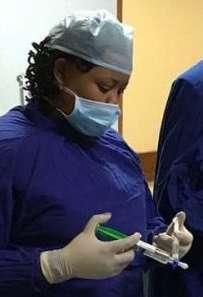
 By Philip Etyang
By Philip Etyang
It was song and dance at Kenyatta National Hospital’s (KNH) Ward 4A, when conjoined siamese twins Niphah Shanice and Miphah Shantel celebrated their one-year birthday on 30th November 2022.
The nursing staff, doctors, patients and well-wishers, joined Ms. Lillian Moraa, the mother to Niphah and Miphah in celebrating the milestone.
Speaking during the event, Ms. Moraa thanked the KNH staff for their exceptional service during the one-year she has spent at the hospital, caring for her twins.
“I arrived at KNH on the 1st of December last year (2022). Since then, I have been handled with a lot of care. Very many
well-wishers and sponsors have visited me to offer the needed support. I say thank you to the KNH staff,”said Ms. Moraa.
The twins were born on the 30th of November 2022 at Lenmek Hospital, Kisii County before being transferred to KNH for specialized treatment and possible separation surgery.
“This is a very special day to all of us. The twins are very healthy and now weigh 11.0 kgs,” said an elated Ms. Moraa.
Reverend John Kanyi, a healthcare chaplain at KNH, opened the event with a word of prayer. He also revealed that he was part of the status conference that was held oneyear ago when the twins arrived at KNH for specialized care.
Dr. Yvonne Olwang, a Resident
Pediatric Surgeon at Ward 4A, who has been caring for the twins and the mother, and was involved in the planning of the birthday event for the twins, said she was happy with the progress of the twins.
“God is good. We thank Him for seeing Niphah and Miphah throughout this year. May He continue working through us for His good,” she added.
Ms. Emmy Talam, a Senior Assistant Chief Nurse on her part thanked everyone for making the event possible. “From the Director Nursing office and the office of the Deputy Chief Nurse at KNH, we would like to appreciate everyone’s efforts in ensuring today was a success,” she said.
“It is important for the children
in the rest of the ward to see that there is more than just blood in the ward. We have cake and snacks whenever somebody is celebrating a birthday,” Ms. Rose Njoroge, a Counseling registered Nurse and Counseling psychologist at Ward 4A revealed.

“The reverend takes care of the spiritual aspect. We take care of the emotional and psychological well-being of the mother,” she added.
Ms. Moraa flanked by Dr Olwang and Ms. Njoroge cut the two cakes amidst song and dance from the patients and staff who had joined her in celebrating one-year since the twins were born.
Mr. Francis Nyabuto, the ward manager and Assistant Chief Nurse while congratulating Ms. Moraa for her achievement, called upon everyone to come together to support Ms. Moraa.
Ms. Sharon Okeyo, a Senior Assistant Nursing Officer said that Baby Niphah and Miphah’s case was a special one that required a lot of studies and
By Luke Kung’uMartha Muchira
KNH is doing amazing work.
Solomon Okoth KNH mambo yote.
Benbella Ahura
“God is good. We thank Him for seeing Niphah and Miphah throughout this year. May He continue working through us for His good,”
consultations before any form of separation surgery can be performed. This is as a result of the two-sharing critical internal organs.

awesome and kudos doctors in ward 4A may God bless you all.
Collins Oyugi Best hospital.
Aro Baha Best hospital ever, saved my life.
Congratulations to the graduands. Hongera.
Hello KNH, greetings from Uganda plus my you continue soaring high.
Prisca Makau
Congratulations to KNH School of Nursing fraternity.
I received good services Pale 9D, mbarikiwe sana.
Florence Wangui
True, the way my son was treated,
Solomon Okoth Elders wetu pia wako safe na KNH.
Collins Oyugi Best hospital in town.
Kimutai Meli
Keep up the good work.
Sheila Kimani
Good things happen in KNH every day.
Joseph Mutety Great job, keep it up.
Kenyatta National Hospital (KNH) is an equal opportunity trainer and employer. The institution does not discriminate on grounds of gender, color, race, religion, natural origin, age or physical/mental disability.
With all this in mind, KNH has been on the forefront in providing equal opportunities to all people. In the recent past, people with special needs have been deployed in various wards, offices, departments and clinics. These include both students and employees where equal learning, training and employment opportunities are availed to all.

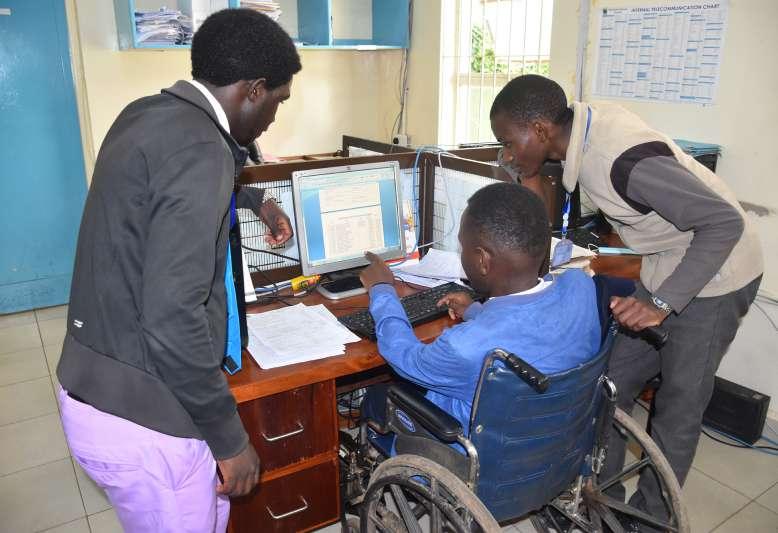
Newsline interviewed three people from different departments each with different special needs. These are their testimonials;
“I am 20 years old and currently a student at Ekerubo Gietai Technical Training Institute in Nyamira County, studying Diploma in Human Resource (HR). KNH embraced me and I am now part of the big family,” said Mr. Tado
“When I applied for attachment through National Industrial Training Authority (NITA), all procedures were followed. Alas! I was well received at KNH and the guidance through getting attached to HR was smooth. I followed the rules and began my attachment on 12th September, 2022,” continued Mr. Tado.
The institution currently has desks which are friendly therefore, someone doesn’t strain their muscles while doing any office work. There are several ramps in various sections of the hospital making movement manageable. Parking reservations have also been put in and are well marked at the KNH Administration Block to serve persons with special needs.
There are also well labelled ablution blocks around the hospital to serve clients with special needs. Such facilities are constructed as
per the guidance and specifications of the National Council for Persons with Disabilities. (NCPWD)
Mr. Tado has been attached to various HR sections such as HR registry, Staff Welfare, Recruitment and Selection to name a few. He feels that it could not have been easier, ‘I was advised by an institution to have my own assistant. This is not the case at KNH, everyone wants to lend a helping hand daily from both the management and staff. I have since made friends who are also my assistants. Kudos to Mr. Jackson Wambua and Mr. Victor Mutisya. I will never hesitate to recommend anyone like me to come to KNH for attachment or even a job.’ concluded Mr. Tado.
You regularly meet Mr. Chira through the wire. His voice commands great respect professionalism and authority when serving customers at Telephone Services Unit. He indicates that during his childhood, he had to face many hardships as it was a taboo in their culture to be like
him.
“I was born with poliomyelitis and no school could admit me. Thus, I started my primary school education at 10 years. This was after my grandmother hid me from my family. Later after completion of my ‘O’ Levels, I went ahead to study a course in Electrical and Electronics Engineering at Machakos Technical Training Institute. Getting a job became an uphill task as I had to search for more than five years. Behold KNH gave me a chance at the Telephone Services, a unit that I have served diligently since 1994. Without looking back this is my other family,” said Mr.Chira
“KNH has given me a chance to get back to school. Recently, I was taken through a Senior Management Course sponsored by KNH in 2021 at Kenya School of Government. I can not thank the great institution enough as they were gracious enough to take me to Multimedia University to study Certificate in Telephone Supervisory and Management in 1998 and 2002 respectively,” continued Mr. Chira
The institution also provides sporting activities for the KNH Paraplegic Team. Mr. Chira boasts of several medals as he plays darts as well as a seasoned marathoner in the 42km wheelchair race.
“I came to KNH single, am now married with seven children and three grandchildren who keep me busy. The institution has also provided me with walking aids, medication, orthopedic and physiotherapy sessions whenever I need them. My 28 years in the institution are a testament of this,” concluded Mr. Chira.
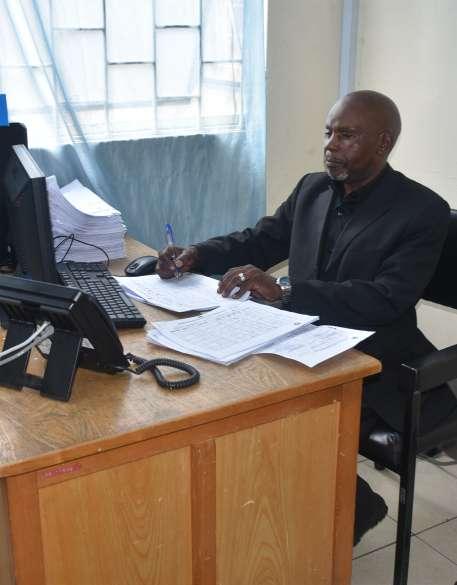

He is always bubbly and full of energy as he prepares food at the main kitchen. Mr. Chacha is a student at National Industrial Training Authority studying Diploma in Food and Beverage Production.
Time is right to serve the patient food, he quickly urges the fellow team players to hurry up. Not known to many, Mr. Chacha, who has a hearing impairment, doesn’t let the disability deter him from doing what he loves, which is cooking.
“I am 25-years-old and the second born in a family of three. I am the only child who was born with a special need,” said Mr. Chacha in sign language. When I applied for
attachment to KNH, I was waiting eagerly. This is because I came across a KNH staff member who uses the Kenya Sign Language in communicating to its clientele who are both staff, patients and students. I have never been discriminated and I even give new recipes to the management. Everyone in the catering department is willing to support me,’ continued Mr. Chacha.
Mr. Chacha has been deployed to the Rahimtullah kitchen, KNH Hostels, diet kitchen, staff canteen service and production points.

Everywhere he goes, he oozes positive energy as he is fun to be around. A new atmosphere has been created in the Catering Unit as everyone wants to learn a few words in sign language. He intends to be a great chef in the future, specializing in preparing several meat dishes and barbeques.

He says that he will always be the
in spreading it’s inclusivity agenda to the people with special needs in his school.

Communication is one of the organizational functions that help a company stay effective, efficient and productive.
The importance of communication between different departments in an organization becomes most evident when that communication breaks down. Implementing policies to strengthen inter-departmental communication help to underscore its importance and maintain an efficient flow of information. While each department within a company handles different tasks, they are all must be able to work together to help the company grow and thrive.
Helps in creating trust among the team
Accurate and efficient communication between departments builds trust within the organization. When departments trust each other to deliver accurate information, this eliminates the extra fact-checking step that can slow down productivity.
Departments should ensure that the information they are giving to other departments in the organization is reliable to help improve operational efficiency.
When inter-departmental communication is poor, customer service can suffer. For example, if a client continues to receive a bill for an invoice that was already paid because the accounts receivable department is not communicating properly with accounts payable, then there is the risk of complaint from the clients and losing repeat business.
To retain clients and ensure the flow of repeat business, you need to maintain a high level of customer service. When the departments in your company are efficiently sharing information, then clients can be properly attended to, and customer service improves.
A breakdown in communication at any point in the organization can result in conflict. Fingerpointing and arguing accompany a breakdown in inter-departmental communication.
When departments engage in conflict, the productivity of your entire organization is affected. A worker or manager who can contribute the advantages of good communication – efficiency,
trust and service – and avoid the pitfalls of unnecessary conflicts and finger-pointing is an employee whose work will gear towards better performance of the organization.
Effective communicators get noticed. Make it your mission to enhance communication within your organization, with a special focus on making sure your department is actively communicating to other company departments.
Good communication may not be a guarantee of quick advancement, but poor communication can most certainly hold you back.
In conclusion, many organizations, for better or for worse, run on memos. Keep your memos concise, clear and professional. Make sure they are well-written, with attention to spelling, grammar and overall clarity.
In general, it is better to send memos to too many recipients than it is to overlook an important recipient who may feel “out of the loop” if not copied on the latest inter-departmental message.
The success story of the rehabilitation of Kenyatta National Hospital (KNH) facilities goes back to the early 1980s. On completion, however, the hospital began experiencing numerous environmental management and maintenance problems. The hospital management found itself with increased bed capacity, which shot from 640 beds to 1,209.
The rehabilitation project of KNH, achieved several milestones. First, the repairs of dilapidated buildings improved patient’s environment through enhancement of cleanliness and boosted staff morale. It also brought buildings and equipment to manageable standard.

By the end of the project in 1998, the Hospital had received a major
facelift of all its facilities. The areas covered include:
(i) Kitchen and Dining Hall (ii) Main Hospital Complex (iii) Clinical Laboratories (iv) Medical Laboratories (v) Tower Block (vi) Lecture Theatres (vii) Laundry Block
Remodeling of the existing space increased the available patients’ space, the patients flow to the facility and efficient utilization of those spaces. The remodeling was aimed at minimizing maintenance and operational costs. This it achieved through reduced utility costs for high-cost services, maintenance, electricity, water, medical gases and steam.
The areas that received upgrading under the rehabilitation project include; the expansion of the already existing Private Wing, creation
of additional doctors’ offices, new doctors’ suites (Doctor’s Plaza), upgrading of the Chapel, Radiology, Casualty and Emergency departments.
Other works, include burglar proofing of windows and doors, sign posting around the hospital, and the installation of more ground water tanks.
The external works included; repairs of roads, car parks, fencing, control posts and storm water drainage, replacement of outdated and obsolete electrical distribution system and power sub-station switch gears and cables, and finally, the upgrading of water and steam distribution systems.
New works that took place in the expansion project includes the installation of the Oxygen Generating Plant, building of a new mortuary with a capacity of 120 bodies, construction
of new ground storage water tanks, and a new Sterile Production Unit.
A manual on preventive maintenance systems was put in place to minimize equipment breakdown and enhance their availability.
Technical training programs have also been established for in-house capacity building. This has enabled about 70 percent of all maintenance works being carried out in-house at reduced costs.
This created a large area of buildings and grounds to be maintained. At the end of the expansion project, there were no corresponding maintenance capacity to ensure continued functioning of building associated engineering, infrastructure, plant, machinery and medical equipment. This led to frequent breakdown of equipment, dilapidation of buildings and rapid deterioration of services.
In 1992, the board established a Development and Maintenance Committee to facilitate:
(i) Preparation of full inventory of buildings and all equipment requiring repairs, rehabilitation, renovations or replacement.
(ii) Develop a comprehensive rehabilitation project proposal for funding by GoK and donors for implementation.
(iii) Thereafter, put in place a satisfactory and long-term preventive maintenance for all Hospital assets.
Between 1992 and 199, donors principally the Netherlands government, the Japanese government through its state agency; Japan International Cooperation Agency (JICA) and the World Bank, gave substantial financial support to the Hospital to complete the expansion project. The funding was given as follows;

1. JICA (For diagnostic equipment)- Ksh.670 million
2. Netherlands (Diagnostic equipment) -Ksh.150 million
3. World Bank (Civil works, plant and equipment) -Ksh.583 million.
4. World Bank (Equipment) -Ksh.300 million.
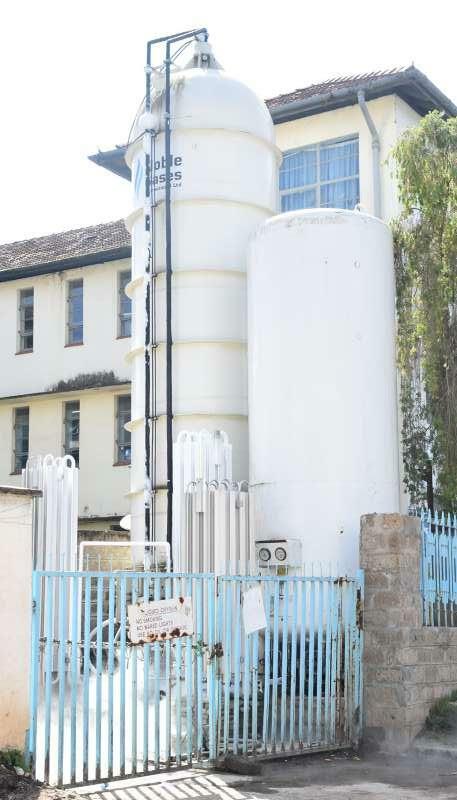
Other key partners who have also supported the hospital in a variety of ways to improve its facilities include the UK, Sweden, Italy and Israel governments.
New works that took place in the expansion project includes the installation of the Oxygen Generating Plant, building of a new mortuary with a capacity of 120 bodies, construction of new ground storage water tanks, and a new Sterile Production Unit.
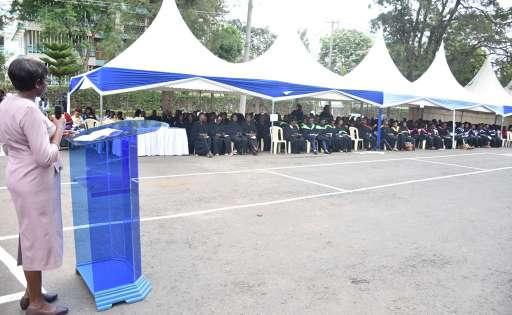
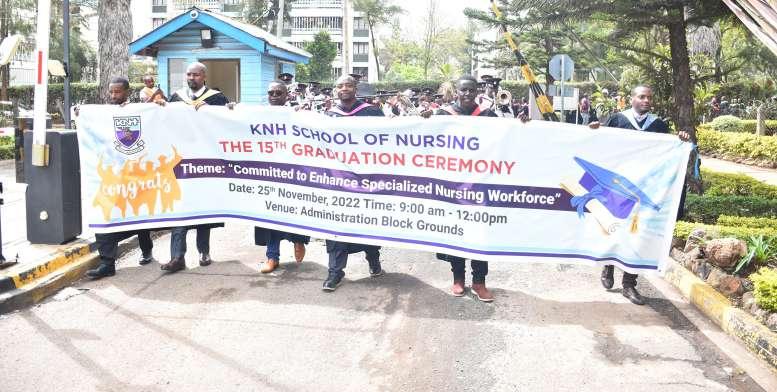 By Linnette Leyi
By Linnette Leyi
The KNH School of Nursing (SoN) held its 15th graduation ceremony on 25th November 2022 with the theme “Committed to Enhance Specialized Nursing Workforce” at the KNH Administration Block Grounds.
The ceremony which kicked off at 11a.m started with a procession led by the Administration Police Band that played lively melodious tunes that rang through the Hospital premises.
One hundred seventy (170) nursing specialty graduates were conferred with higher diplomas and certificates in six specialty areas namely critical care, perioperative, nephrology, accident and emergency, oncology and neonatal nursing. The school has trained 1,740 specialized nurses since inception in 1996.
Speaking during the event, SoN Principal Mrs. Jane Chore saluted the graduands for staying on course and completing their training. She thanked the Council for supporting the school in curriculum development, accreditation, and examination.
She emphasized the role played by specialized nursing in achievement of
the national Universal Health Coverage (UHC) goals. “More specialized nurses are required to help realize efforts by the government and Ministry of Health to help communities access specialized nursing. The school commits to adhere to the Council’s and government’s guidelines and standards on quality nursing training,” she added.
Also addressing the graduands, their families and friends, partners and stakeholders as well as School of Nursing faculty members and staff was the Acting KNH CEO, Dr. Irene Inwani, O.G.W who expressed her hearty congratulations to the new graduates.
“The theme today emphasizes our dedication to achieving our vision of providing quality specialized
health care. The KNH management will support the school in its endeavour to churn out qualified specialized nurses into the labour market,” she remarked.
Nursing Council of Kenya Registrar representative Dr. Gladys Machira who was the chief guest at the occasion, congratulated the school for the big role they are playing in building capacity in the nursing profession. “As the Council, we are satisfied that the school has prepared the graduands to contribute to the health sector both locally and beyond the borders,” she said.
The event ended with a joyous session where the chief guest conferred the graduands with their Higher Diplomas, Certificates and Merit Awards.
Department: Nursing
Tasks: Assessing, planning, and implementing nursing interventions, providing health education, facilitating client admissions and initiating discharge plans, taking part in administering immunization to adult and pediatric clients, implementing hygiene procedures to create a safe and tidy clinical environment, and participating in weekly continuous medical education (CME) programs.
Three things you’ve learnt about KNH?
1. KNH is the biggest referral hospital in East& Central Africa.
2. KNH is client-centered, right from its Motto We Listen, We Care.
3. It has a student department, Nursing Standards, Students & Research, which coordinates clinical placement and research.
How has the internship added value to you?
I have gained skills holistically, not limited to those relating to nursing care. Through the mentorship of nurses and multidisciplinary team members, I have identified my strengths and realized my abilities in clinical care. Further, through networking, I have learnt from senior colleagues and I have greatly improved my professional visibility.

Most memorable moment at KNH?
Taking part in the 2022 Vesicovaginal Fistula (VVF) campaign, a collaboration of KNH, MPESA Foundation and other partners. The smiles from those mothers as we nursed them to recovery moved my heart.
Your Career plan after the internship?
I have a great interest in academia. I want to advance my studies in pediatric and child health after my internship and take roles in teaching and research in the future.
A day well spent takes more than the act of waking up, preparing for the day and the actual work scheduled for it. Every ticking second opens a new dawn to opportunities and there is more to it than meets the eyes.
The input determines the output and the satisfaction drawn from the work. At the end of the day and as one prepares to sleep, after saying a word of thanksgiving, we lie down to sleep hoping to make it to another day. Our fate lies with the mercies of our maker.
Fast forward to the next day, the routine repeats itself. Waking, bathing, taking breakfast and leaving for work We are hopeful for another successful day. This is the story that Supplies Chain Management Officer I, Mr. Nicodemus Odima reminisces of the events on that fateful 25th day of January 2022…. Read on …
Good morning Mr. Odima. Kindly tell us what a typical day used to be like before and after the accident.
Well, it was on 25th January, 2022. My family and I usually wake up at 4.30a.m. to prepare for the day’s activities and by quarter to 6.00 a.m. I escort my children to Mimosa stage as they board a school bus, then I walk to work. However, as fate would have it, it was a nightmarish day, one I can never forget. I vividly remember escorting my children to the stage and they boarded the usual school bus and I started to walk to work. When I got at the Daystar University zebra crossing, I waited until the road was clear. To my right, there was also a bicycle rider who was also waiting for traffic to clear.
No sooner had the traffic cleared than the bicycle rider mounted his bicycle and began crossing. I followed suit but barely in the middle of the road, a car that seemed to drive to the same direction as the bicycle veered in front of the cyclist; the rider tilted the bicycle’s front wheel so fast and when I saw this, I backtracked hoping that the car would go straight on. Instead, it moved in the same direction as I was and hit me so hard
that it broke my right leg tibia. The impact was so massive that it broke my right-hand femur as I fell with a thud. The vehicle disappeared from the scene.
As I lay down writhing in pain and shock, I managed to shout for help. Luckily the Daystar University junction is manned by keen traffic police officers who came to my rescue. They called upon the passersby who lifted me to the roadside. One officer inquired whether anyone could identify me and fortunately, I recalled and gave my wife’s mobile number which they used to call her and she coordinated well with the police.
A good Samaritan volunteered his car which ferried me to KNH Accident and Emergency. A colleague assisted in processing my admission including pushing the stretcher that I was placed on, and taking my blood samples to the laboratory. At around 1.00p.m I got an admission at KNH Prime Care Centre (KPCC).
We are cognizant of the fact that you are currently using crutches to aid in mobility, what is the story behind this?
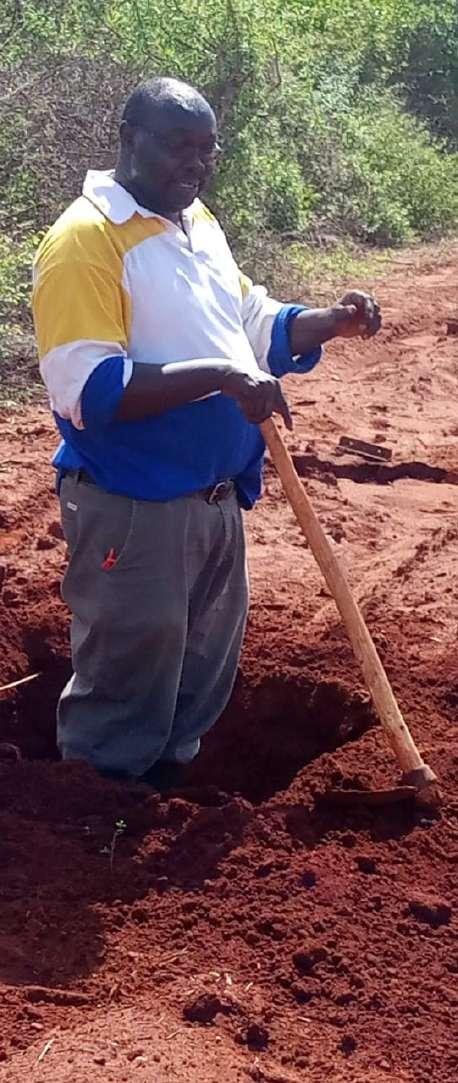
Well, I was discharged on a wheelchair on 12th February 2022. For four months I had to be pushed around in the house and when visiting the Orthopaedic Clinic for reviews. In the fifth month the doctor prescribed two armpit auxiliary crutches to aid in mobility. From a wheelchair to crutches was a big relief.
Though I felt the relief, it came with several challenges. The crutches resulted in painful swollen armpit sores. All this time I was unable to use the stairs; my right leg which had a metal implant could not bend, this jeopardized my chances further in that at my work place we do not have disability-friendly lavatories. This compounded the problem since the more I take solid food, the more the urgency for long calls. What does this mean one may ask; it is prudent and almost straightforward to partake only soft drinks during the day hence no need to rush for long calls of nature. I literally spend the working days on a hungry stomach.
Now that it was a hit-and-run situation and the fact that in some scenarios, we have witnessed people being robbed, did you lose any of your valued items such as mobile phone or money?
The only things that got destroyed completely were my eyeglasses that fell on the road and were crashed to smithereens, my tablet screen
cracked extensively and my clothes were also torn. Fortunately, enough all my personal belongings like IDs, bank credit card and NHIF Cards were intact in the pockets. I think the presence of the hawk-eyed police officers manning the junction acted as the ultimate deterrent as well as the quick and timely evacuation to KNH by the good Samaritan did the trick.
How did you get to the hospital for specialized treatment? (a brief on the treatment, duration and the cost if possible)
My wife, police and colleagues at work assisted me to get to the hospital. The admitting doctor

performed surgery on me at around 11.00 p.m. and there were implants which were inserted in my broken leg and arm. My wife also coordinated blood donation for my transfusion from friends and relatives. I spent almost two weeks in the hospital.
Have you received any remunerations pertaining the circumstances that led to the situation you are in now?
(Compensations in monetary value or lesser working hours)
None so far.
What are the challenges at your workstation especially the lavatories and disability-friendly environment
(accessibility to other offices/speed of service delivery/attitude from other staff and friends), what could be possibly done by the institution to alleviate the problem? (Disability mainstreaming)
The greatest challenge is the mobility in places where there are staircases; I really get tired and strain my right leg and arm. Secondly, I would urge the management to consider building disability-friendly lavatories at the workplace. Wet floors give a terrifying experience since crutches are prone to slip therefore resulting to debilitating falls; there is an urgent need to maintain all floors dry. I would also urge all to get rid of items (and vehicles) on freeways such as walkways and corridors since they obstruct movement for the disabled.
What is the sum total of the impact to day-to-day activities and life in general? (at work, home, social activities, hobbies, modes of transport, attire etc.
Life has become too expensive. I have been rendered unable to use public transport means like matatus and have resulted to far safer means such as taxi-hailing Uber or Bolt to get to my workplace. Mobility is further made difficult during rainy seasons owing to the slippery grounds and mud. Secondly, I cannot mingle freely with crowds due to push and shove that is identified with such. I feel disoriented since I cannot lift heavy objects or walk long distances as I used to. So many simple tasks that I used to do are now a herculean task that I always ask someone to do for me. I hope one day I will regain my strength and get back to my usual bubbly and energetic self.
Before the accident, I was 100 percent normal. I could walk to and from town, do a lot of manual work at home and at even at the workplace. Every person is a potential to disability; today is me tomorrow may be someone else. Let us create a better and enabling environment for us and generations to come. No one knows what the next second, minute or hour holds. It is an illusion that only God knows.
Thank you.
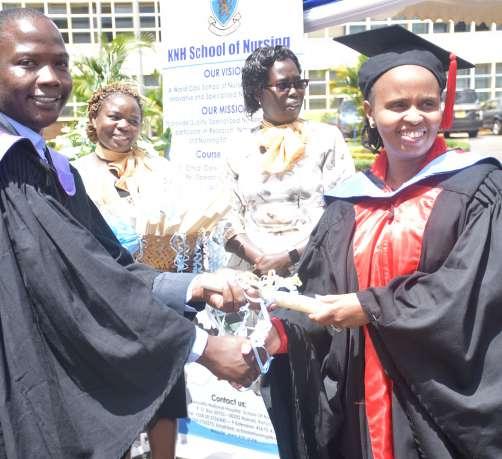
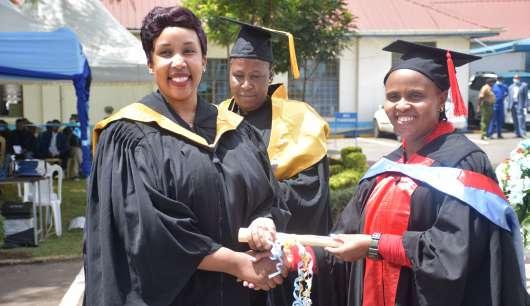
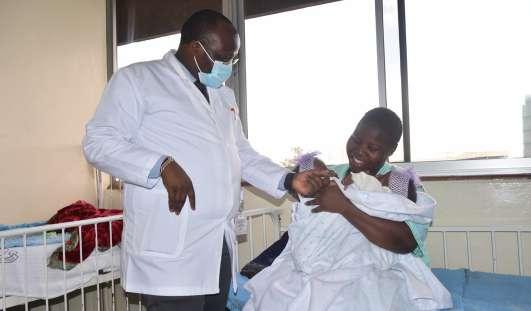
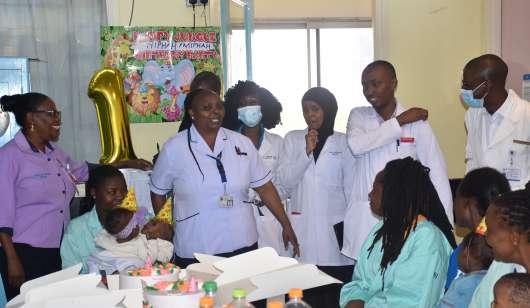
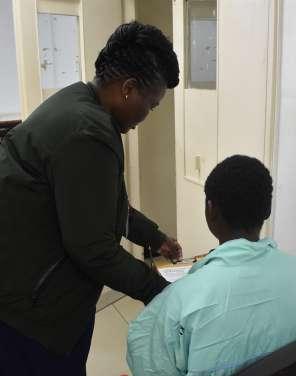


In an increasingly competitive and economically fragile world, organizations have to ensure that customer needs, wants and expectations are addressed for the customers to return (brand loyalty) and or for the business to remain profitable.
As opposed to other industries, health care patients do not want to be there. Being in a hospital is scary and all that patients need is attention and communication. Given the impending changes in health care, hospitals, therefore, need to ensure top-notch customer service.
Kenyatta National Hospital Prime Care Centre (KPCC) has a genuine desire to deliver customer service that their customers will remember for the right reasons. KPCC backs up this intention with its vision to be “A world-class center in the provision of prime healthcare services,” the mission “To provide quality and competitive health care services and engage in mutually beneficial partnerships,” and the motto “We Value You.”
The KNH private wing has taken its customer service credentials even further with the KPCC Human Resource Unit organizing a fourday class-based Customer Service awareness workshop. The training took place at the Kenyatta National Hospital Training and Research Centre from 28th November to 1st December 2022. Facilitated by the Marketing and Communication Department, the in-house training was conducted by Ms. Edel Q. Mwende (Manager, Marketing and Communication) and Mr. Peter Githua (Senior Customer Care Assistant).
The 100 trainees in total were sensitized on the KPCC Products & Services, the Hospital Marketing and Communication Policy, Customer Service: The ABCs of Customer Service: Interpretation, Skills, Tips and Etiquette and Emotional Intelligence for non-verbal cues.

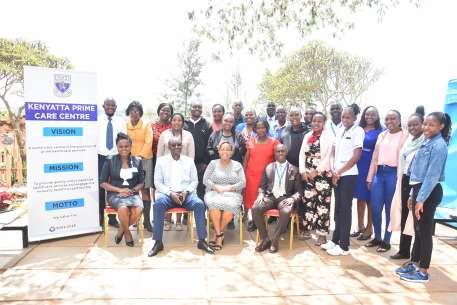
In addition, the workshop highlighted Why Customer Care Matters in Healthcare, Service
Delivery Charter and Customer Feedback Mechanisms.
Speaking during day two of the training, the Senior Director KPCC, Dr. John Ngigi, emphasized the need for great strategies in organizations, the importance of prime customer service and engaging in mutually beneficial partnerships in order to create value, lasting relationships and return clients. Basic tips and tricks such as communicating effectively and on time, greeting, smiling and serving patients and relatives well are essential.
“Customer service is the sole responsibility of everyone in the organization. The success of the organization and positive brand image depends on how well employees serve their customers. It is not the responsibility of the Marketing and Communication department only. As Hospital staff, we are responsible for upholding the brand image,” said Ms. Edel.
“Our customers are both internal and external and they all bring value to the organization hence we should all endeavor to anticipate customer needs and optimize the customer’s
experience as guided by the mission of Kenyatta National Hospital,” said Mr. Githua.
There are six (6) pillars of outstanding Customer Service that separate the extraordinary from the mundane consist of Attitude, Interest, action, Verbal language, body language and tone of voice. Whether there are 50 or 500 patients in a hospital, it is a patient’s right to feel as though they are the only ones there. Customers may forget your words but they always remember how you made them feel.
In conclusion, it is vital to live by the core values of KPCC; Professionalism and Integrity, Responsiveness, Empathy, Teamwork and Team Spirit and Innovativeness for excellent customer service experience.
keting
Communi cation, KNH-Ms. Edel Q. Mwende (L), HR
KPCC-Ms.
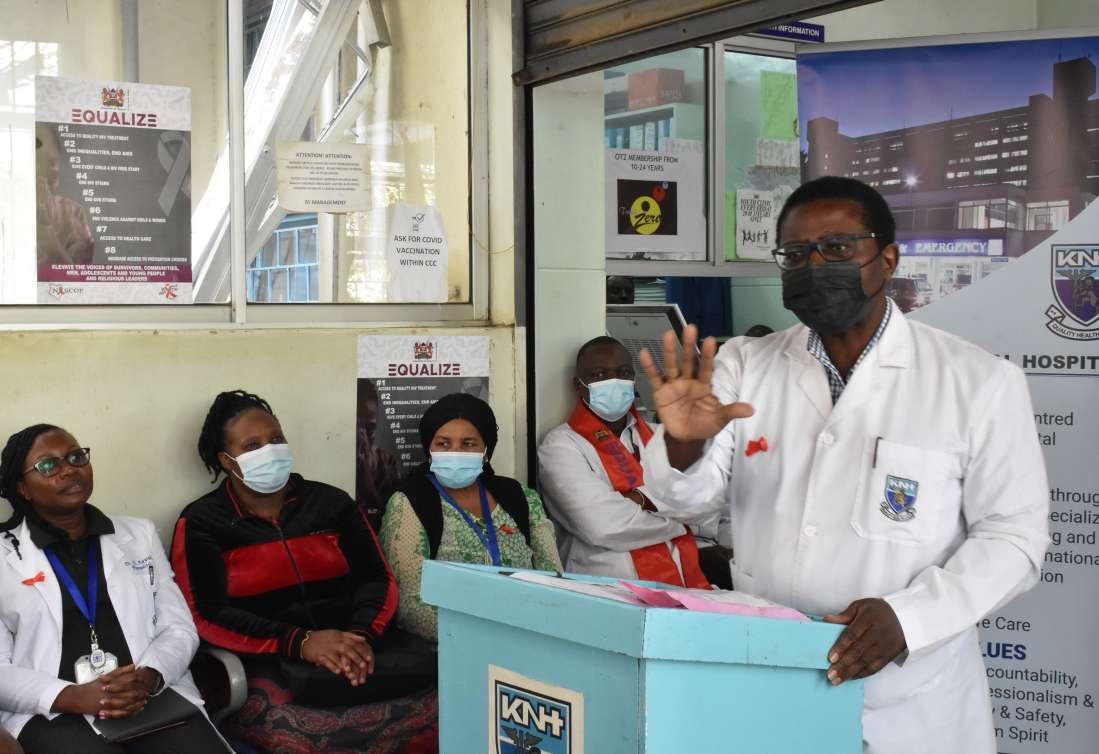 By Luke Kungu
By Luke Kungu
Kenyatta National Hospital (KNH) participated in this year’s World AIDS Day on December 1st, with the theme ‘Equalize’ at a function held at the Comprehensive Care Center (CCC). It was graced by Director, Connect Project Dr. David Bukusi.
“We have seen an increase in development of services and have adjusted to address the needs of clients over the years. Thankfully, the Hospital management has set up services that are committed to provision of quality specialized care for patients.
However, mother to child transmission still poses a problem, adolescents are a significant source of new infections which is exacerbated by mental health, stress and stigma. To this end we need to equalize and play our part,
individually and severally as we endeavor to manage HIV,” said Dr. Bukusi.
Speaking during the event Head of Unit, CCC Dr. Dorothy Aywak noted that the theme is a call to action that prompts all of us to work for the proven practical actions that are needed to address inequalities and help end AIDS. “These interventions include
“There is an urgent need to reform laws, policies and practices to deal with stigma and exclusion faced by people living with HIV as well as marginalized populations to ensure that everyone is respected and welcomed,”
Dr. Aywak
but not limited to: increase in availability, quality and suitability of services for HIV treatment, testing and prevention to ensure that everyone is well-served.
There is an urgent need to reform laws, policies and practices to deal with stigma and exclusion faced by people living with HIV as well as marginalized populations to ensure that everyone is respected and welcomed,” added Dr. Aywak.
The event’s major activities were health talks that touched on: leadership in HIV, importance of nutrition, discordant couple clinic (DCC) support, social work as well as patient testimonials. Members of the public also benefitted with free HIV testing and free self-test kits.

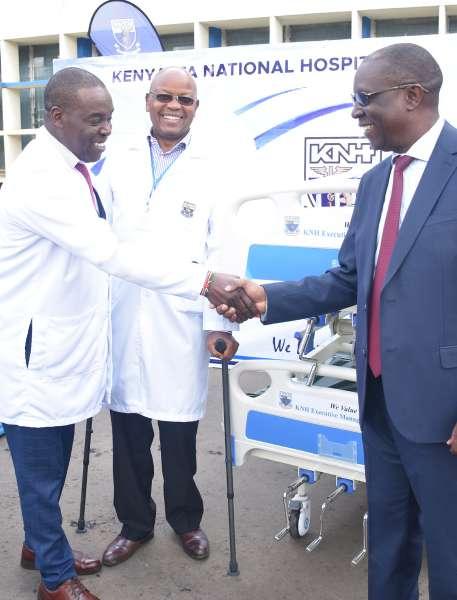 By: Yvonne Gichuru
By: Yvonne Gichuru
On Thursday, 1st December, 2022
the KNH Executive Management Committee Members (EMC) donated 12 beds to support the Adopt a Bed campaign initiated to provide enhanced comfort to the patients during their stay in the Hospital.
Mr. George Ooko - KNH Board Chairman, who received the donation, said the idea is to replace the old beds that we’ve had for decades.
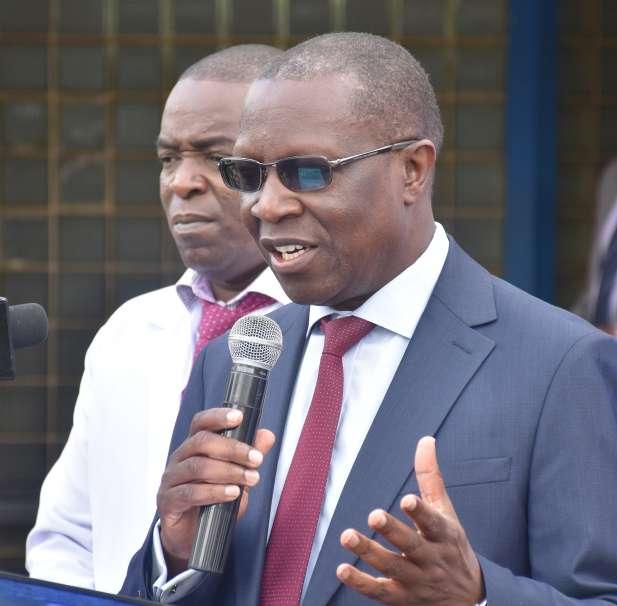
A significant number of these beds are obsolete and those in usable condition have limited functionalities required for the provision of specialized treatment offered in the Hospital.
“So far we have received 222 beds from various donors and we still have a long way to go. We would like to appeal to more donors to join us as we aim to achieve the target which is 2000 beds.”
“Thank you EMC for your contribution and we look forward to more.” he concluded.



An exhausted blonde dragged herself to the doctor’s office.
“Doctor, there are dogs all over my neighborhood,” she said.”They bark all day and all night, and I can’t get a wink of sleep.””
“I’m going to prescribe some sleeping pills,” said the doctor.”A few of these and your troubles will be over.”
“Great,” said the blonde.”I’ll try anything.”
A few weeks later, the blonde returned, looking worse than ever.”Doctor, it didn’t work! I’m more tired than before!””
“I don’t understand how that could be,” said the doctor, shaking his head.”Those are the strongest pills on the market!”
“Maybe so,” said the blonde, “but I’m still up all night chasing those dogs, and when I finally catch one, it’s hell getting him to swallow the pill!”
What does a doctor with a comedian degree do?
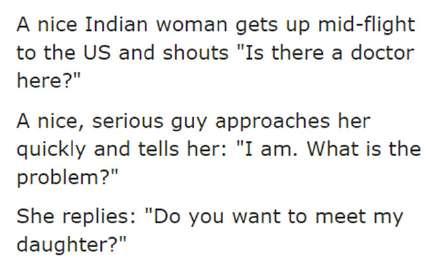
He leaves the patients in stiches
Jack was very fat and his wife was worried about him, so she made him see the doctor...
The doctor weighed him and said, “You must lose 30 kg. Eat only fruits and vegetables and jog 5 km a day for the next 100 days. Then give me a call and tell me how much you weigh.”
Jack went home and did what the doctor told him. 100 days later, Jack called the doctor.
“Jack here. You will be happy to know that I have lost 30 kg.”

“Excellent,” said the doctor.
“There is just one problem,” Jack said. “I am 500 km from home!”
1. Experience is not what happens to you; it is what you do with what happens to you- Aldous Huxley
2. Having a young child explain something exciting he has seen is the finest example of communication you will ever hear or see- Bob Talbert
3. People often say that beauty is in the eye of the beholder, and I say that the most liberating thing about beauty is realizing you are the beholderSalma Hayek
4. Each day comes bearing its gifts. Untie the ribbonAnn Ruth Schabacker 5. Living is the art of getting used to what we didn’t expect- Eleanor C. Wood 6. Kindness is one thing you can’t give away. It always comes back- George Skolsky 7. Success is falling nine times and getting up tenJon Bon Jovi 8. There is only one certainty in life and that is that nothing is certain- G.K. Chesterton 9. The most sincere compliment we can pay is attention- Walter Anderson 10. Be open to learning new lessons, even if they contradict the lessons you learned yesterday- Ellen DeGeneres